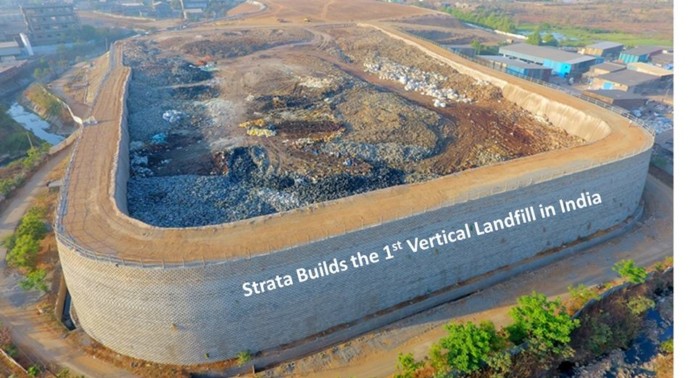Strata Geosystems (India) was faced with a challenge – accommodate two more years of landfill in the already brimming space. Expanding of landfill was not an option. Vapi Green Enviro Limited (VGEL) is in the industrial waste storage services business. With greater demand VGEL needed greater storage volume at its existing landfill site to cater to at least two more years. The landfill was in a congested zone and expanding horizontally would be an expensive and unfeasible option. So it asked Strata Geosystems, a market leader in the geosynthetic segment for soil reinforcement solutions in India and across the globe, for a solution.
The construction of landfills is extremely intricate because it is a complex, multifaceted system. It is designed to protect the ground and surroundings from contamination. Given the burden of a lot of toxic material, landfills take years to plan and develop. They are typically divided into areas called “cells” which are designated areas for storing the waste. Conventionally, landfills are constructed with containment dykes with side-slopes (as flat as 1V:3H), and filled with waste within the containment. Due to flat slopes and limited land availability, there are limitations to the height to which these dykes can be constructed. The flat slopes and limited heights impose a severe restriction to the landfill volume. VEGL had very limited space at its disposal for expansion. The conventional solution did not meet the two year requirement.
Innovative Approach
Thinking out of the box, Strata devised a containment system with a reinforced soil structure, which is a slim, yet safe structure. The lean structure would generate more space for storage. This vertical expansion was made possible without the need for a voluminous earth retaining structure The landfill was divided into cells, and each cell was filled one at a time. The first three cells were closed and covered as per statutory requirements. Strata developed Cell 4. To achieve this, it successfully executed the following:
- a) A horizontal spread – “Cell 4 Extension Part 2”
- b) Vertical expansion of Cell 4 “Cell 4 Extension Part 1”
The complete construction involved two of Strata’s innovative systems: StrataSlope™ and StrataBlock™. The inner slope (StrataSlope™) that bordered the landfill material was a StrataGrid™ (polyester geogrids) fascia wrapped around soil bags. This face was draped with a composite of geo-membrane and nonwoven geotextile to prevent landfill leachate from seeping into the containment. Lastly, to provide a maintenance-free structure, Strata provided an aesthetically pleasing outer fascia. StrataBlock™ (precast segmental concrete modular blocks), in connection with the internal StrataGrid™ using keys, is the face of the wall, providing a “fortress” look to the structure. The total fascia area of reinforced soil containment system is 6,600 sqm.
Impact
- Increased the total dumping capacity by 2.5 times conventional methods
- Cost-effective by providing more storage revenue within the same land space
- Aesthetically pleasing
- Safe and robust to withstand differential settlements without distress
- Rapid construction with sound systems
- Minimal maintenance due to the innovative technologies used
Strata provides end-to-end solutions for soil reinforcement challenges including supply, design, and construction with StrataGrid™ (geogrid) and StrataWeb® (geocells).
www.strataindia.com










